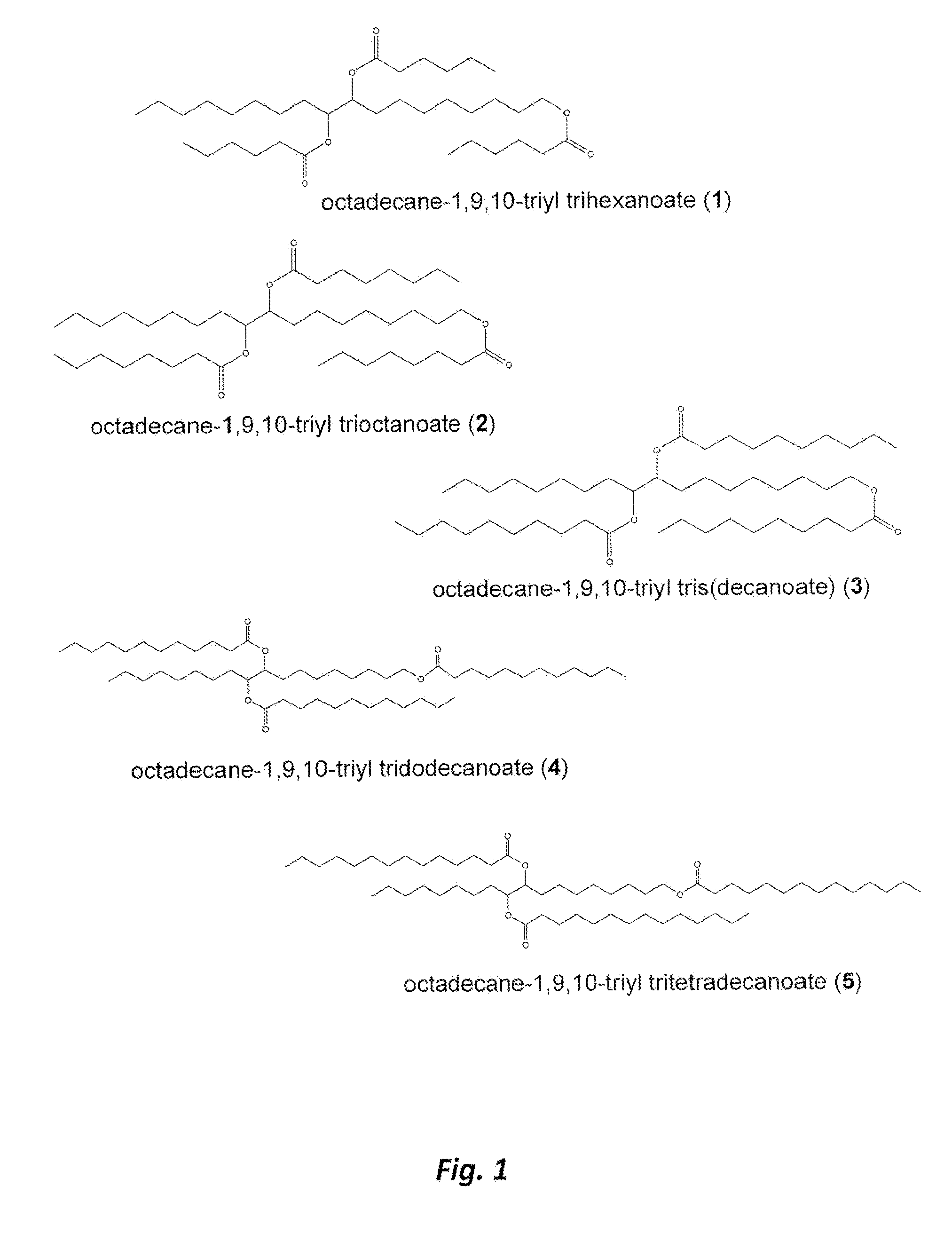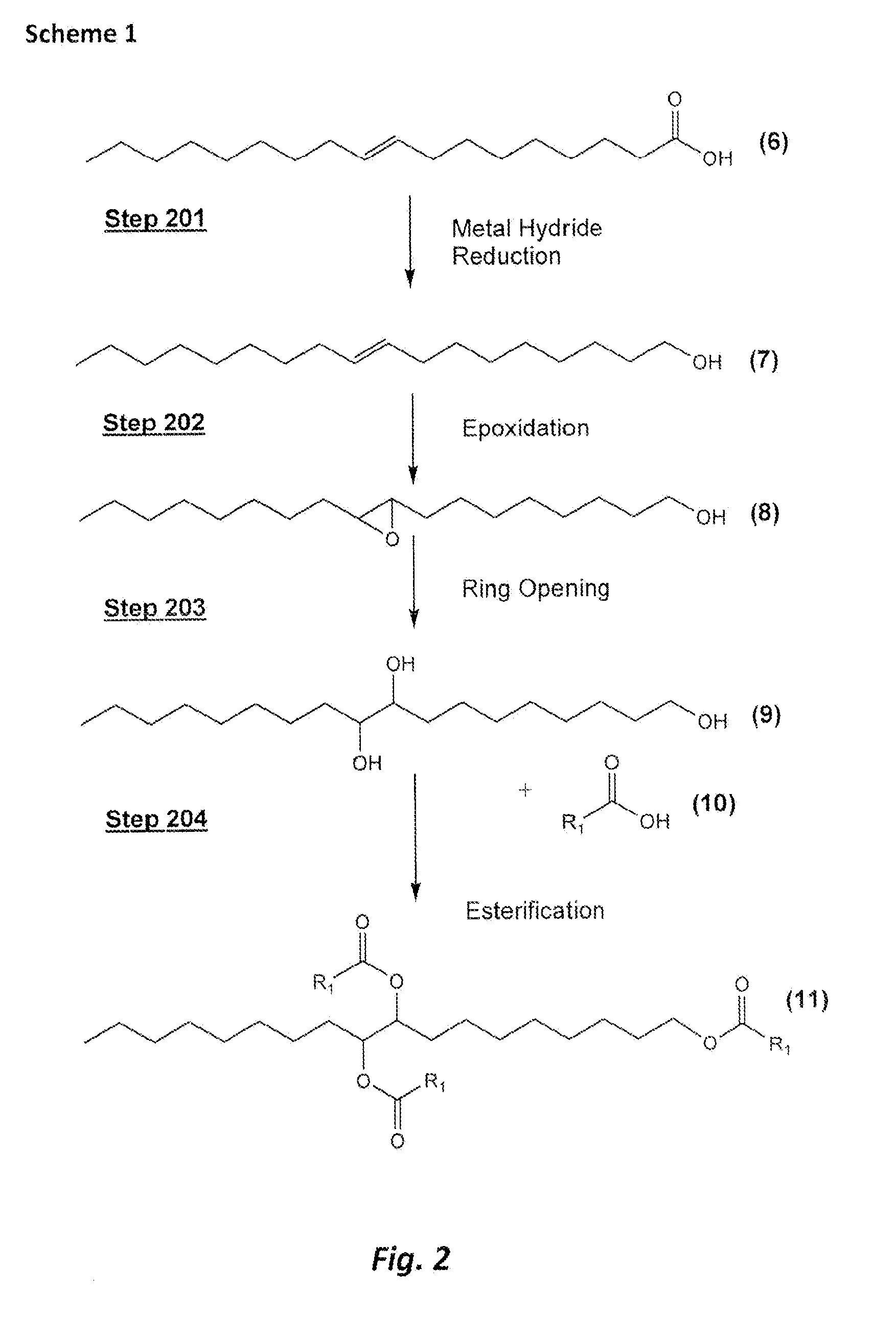Biolubricant esters from the alcohols of unsaturated fatty acids
a technology of unsaturated fatty acids and biolubricants, which is applied in the field of tryter-based lubricants, can solve the problems of more complicated and expensive preparation of esters than the preparation of pao counterparts
- Summary
- Abstract
- Description
- Claims
- Application Information
AI Technical Summary
Benefits of technology
Problems solved by technology
Method used
Image
Examples
example 1
[0058]This Example serves to illustrate synthesis of oleoyl alcohol 7 (an exemplary monounsaturated fatty acid), via a reduction of oleic acid (Step 201a), en route to synthesis of exemplary triester 1 and in accordance with some embodiments of the present invention. Oleoyl alcohol 7 was prepared according to the following procedure.
[0059]To an ice-cold (ice bath) suspension of 43 grams (1.13 mol) of lithium aluminum hydride (LiAlH4) in tetrahydrofuran (THF) in a 3-neck 3-liter reaction flask fitted with an overhead stirrer and a reflux condenser, 150 grams (0.53 mol) of oleic acid 6 was added drop-wise over a period of 45 minutes via an addition funnel. The resulting reaction mixture was allowed to warm gradually to room temperature, after which the ice bath was replaced with a heating mantle and the reaction mixture was refluxed for 4 hours. After reflux, the reaction mixture was allowed to cool to room temperature and stirred overnight. The reaction progress was monitored by infr...
example 2
[0060]This Example serves to illustrate the synthesis of the octadecane-1,9,10-triol 9 (an exemplary triol) (Steps 202a and 203a), en route to the synthesis of triester species 1 and in accordance with some embodiments of the present invention. The triol 9 was prepared according to the following procedure.
[0061]To an ice-cold solution of hydrogen peroxide (110 grams of 30 wt % H2O2) and formic acid (250 grams of 88 wt % HCO2H) in a 1 L, 3-neck reaction flask, 130 grams of oleoyl alcohol 7 (prepared as described in Example 1 above) were added drop-wise over 45 minutes. Once the addition was complete, the reaction was allowed to slowly warm to room temperature and then heated to 40° C. for 3 hours. The reaction was subsequently allowed to stir over night at room temperature. The reaction was stripped on a rotary evaporator to remove excess formic acid. The residual mixture of the triol 9 and its formates was treated with an ice cold solution of sodium hydroxide (45 grains NaOH in 100 ...
example 3
[0062]This Example serves to illustrate how the sequence of steps leading to the triol can be altered, in accordance with some embodiments of the present invention.
[0063]Using a procedure similar to that described in Example 2 (in terms of quantities, reagents), oleic acid 6 was derivatized to the corresponding 9,10-dihydrolyloleic acid which was then reduced with lithium aluminum hydroxide to the corresponding triol derivative 9.
PUM
| Property | Measurement | Unit |
|---|---|---|
| Temperature | aaaaa | aaaaa |
| Kinematic viscosity | aaaaa | aaaaa |
| Pour point | aaaaa | aaaaa |
Abstract
Description
Claims
Application Information
 Login to View More
Login to View More - R&D
- Intellectual Property
- Life Sciences
- Materials
- Tech Scout
- Unparalleled Data Quality
- Higher Quality Content
- 60% Fewer Hallucinations
Browse by: Latest US Patents, China's latest patents, Technical Efficacy Thesaurus, Application Domain, Technology Topic, Popular Technical Reports.
© 2025 PatSnap. All rights reserved.Legal|Privacy policy|Modern Slavery Act Transparency Statement|Sitemap|About US| Contact US: help@patsnap.com



